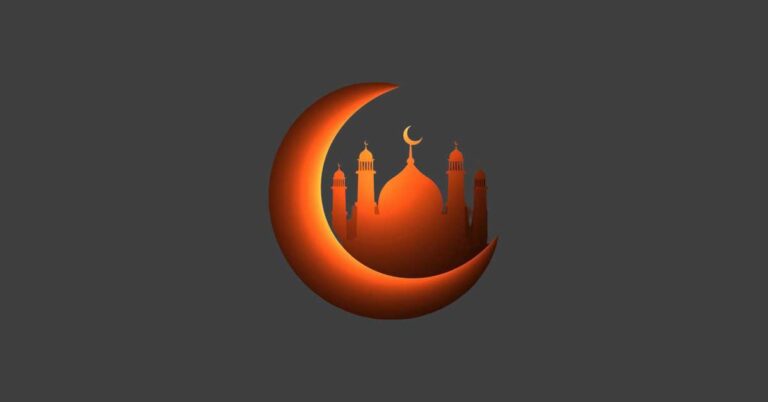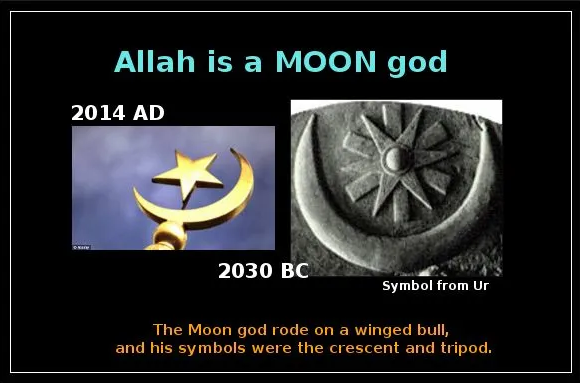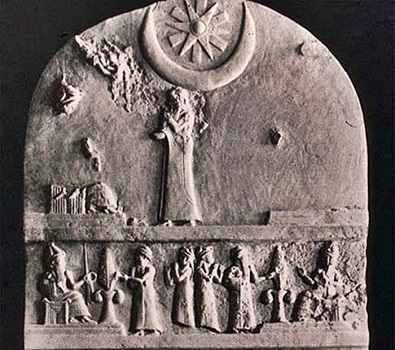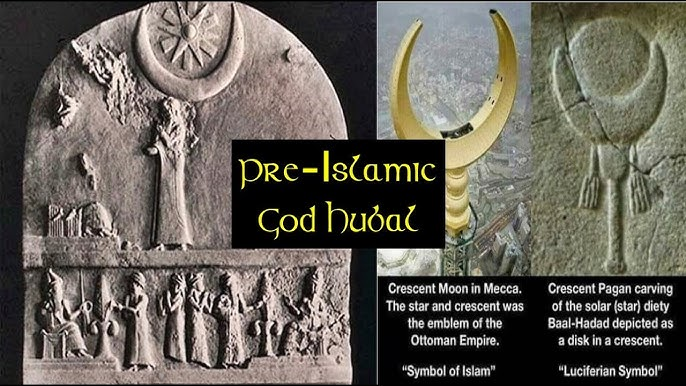Islam and Its Ties to False Worship Rooted in Sin Worship
Islam, one of the world’s largest religions, traces its origins to the 7th century, claiming lineage through Abraham and divine revelation to Muhammad. However, a deeper inspection reveals connections between Islam and ancient false worship rooted in sin-based deceptions. By examining historical, theological, and symbolic ties, we uncover a system designed to mislead, masquerading as truth.

📜 The Origins of Sin Worship in Mesopotamia (c. 3000–2000 BC)
Sin worship, one of the earliest and most widespread forms of religious practice, traces its roots back to the earliest civilizations in Mesopotamia. The deity Sin (also called Nanna) was the Mesopotamian moon god, worshiped in the powerful city-states of Ur, Harran, and Babylon. This worship system not only dominated the ancient Near East but also left an enduring mark on subsequent religious movements, including those of Arabia and beyond.
To fully understand the impact of Sin worship, we must explore its rituals, beliefs, temples, and how it shaped later religious traditions that persist today.
The worship of Sin began in the earliest urban centers of Sumer and Akkad. The deity Sin was believed to control the cycles of time, fertility, and divine judgment, making him one of the most significant gods of the region.
🔹 City of Ur as the Center of Sin Worship (c. 3000 BC) – The Ziggurat of Ur, built under King Ur-Nammu (c. 2100 BC), was one of the largest and most important centers dedicated to Sin. Priests and rulers would calculate the lunar calendar based on Sin’s cycles, reinforcing the idea that he controlled time itself.
🔹 Sin as the Supreme Deity of the Akkadians (c. 2350 BC) – During the reign of Sargon of Akkad, Sin’s influence spread across Mesopotamia. Akkadian rulers would invoke Sin’s name in treaties, believing the moon god’s oversight guaranteed divine favor in war and governance.
🔹 The City of Harran: A Lasting Bastion of Sin Worship (c. 2000 BC – AD 1200) – Harran became the second great center of Sin worship after Ur. Even as empires changed, Sin worship persisted here for over 3,000 years, influencing later Assyrian, Babylonian, and even Islamic traditions.
🌙 Core Beliefs and Rituals of Sin Worship
Worshipers of Sin performed elaborate rituals, sacrifices, and divination practices to appease the god and seek his guidance.
🔹 Moon-Based Calendars and Timekeeping – Devotees of Sin established lunar calendars, believing the phases of the moon dictated agricultural, political, and spiritual cycles. This practice carried into later Babylonian, Jewish, and Islamic traditions.
🔹 Nighttime Sacrifices – Unlike many sun deities who received offerings at dawn, Sin’s followers conducted sacrifices at night, under the moon. These included animal offerings, incense burning, and bloodletting rituals performed by priests.
🔹 Priesthood and Divination – Sin’s temple priests, known as baru diviners, interpreted omens in the moon, celestial alignments, and animal entrails to predict future events. This practice influenced astrology and mystical traditions in later cultures.
🔹 Sexual Rituals in Moon Temples – Many temples dedicated to Sin incorporated sacred prostitution, a practice where women served as priestesses who engaged in ritualistic intercourse to honor the goddess Ishtar (Sin’s daughter) and ensure divine fertility.
🔹 Crescent Moon as a Sacred Symbol – The crescent moon, Sin’s primary emblem, became a dominant religious symbol throughout the Middle East and remains an enduring mark of spiritual power.
🔥 Influence of Sin Worship on Later Religions
Sin worship did not disappear but instead merged with, adapted to, and influenced later religious systems.
🔹 Babylonian Adoption (c. 1800 BC – 539 BC) – Babylon’s high priests absorbed Sin worship into their own pantheon, associating him with Marduk and Bel, integrating his lunar cycles into their mystery religion practices.
🔹 Canaanite and Phoenician Influence (c. 1500 BC – 500 BC) – The Canaanites adapted Sin’s lunar attributes into the worship of Baal and Asherah, incorporating moon-based fertility rituals that later infiltrated Israelite idolatry.
🔹 Persian and Hellenistic Periods (c. 500 BC – AD 300) – Even under Persian and Greek rule, Harran’s Sin worship continued, influencing the Zoroastrian Magi and later Greco-Roman mysticism.
🔹 Islamic Ties (c. AD 600 – Present) – The crescent moon became the defining symbol of Islam, rooted in pre-Islamic Arabian moon worship, which was directly connected to the practices of Sin’s cult in Mesopotamia and Harran.
🏺 Pagan Roots of Islam
Islam did not emerge in a vacuum. Pre-Islamic Arabia was steeped in idolatry, and many of its traditions found their way into the new faith. The Quraysh tribe, which controlled Mecca, facilitated the worship of multiple deities centered around the Kaaba, a shrine that predates Islam by centuries. This pagan heritage is crucial to understanding Islam’s foundation.
🔹 The Kaaba’s Pre-Islamic History – The Kaaba was not originally a monotheistic site but housed over 360 idols of various gods worshiped by Arabian tribes. Even after Muhammad’s claim to divine revelation, many of its rituals remained unchanged, only repurposed under Islamic theology.
🔹 Hubal, the Moon Deity – The dominant god at the Kaaba before Islam was Hubal, a deity connected to the moon and fate. The Quraysh relied on divination using sacred arrows before this idol, a practice that contradicts biblical teachings (Deuteronomy 18:10-12).
🔹 Allah Before Islam – The name ‘Allah’ was used by pre-Islamic Arabs to refer to a supreme deity, among many gods, demonstrating that Islam did not introduce a new monotheistic concept but repackaged an existing one.
🔹 The Black Stone Ritual – One of the most striking remnants of paganism is the Islamic veneration of the Black Stone (al-Hajar al-Aswad). It was previously an object of idol worship, believed to have divine powers. Even in Islamic tradition, it is said that Muhammad kissed the stone, despite no biblical precedent for such an act (Exodus 20:3-5 warns against worshiping physical objects).
🔹 Circumambulation of the Kaaba – The ritual of walking in circles around the Kaaba mirrors ancient Babylonian, Hindu, and other pagan traditions where circular movements around sacred objects signified cosmic unity.
🔹 Sacrificial Offerings and Mecca’s Economic Power – Pagan Arabs would perform ritual sacrifices at the Kaaba. This economic system benefited the Quraysh elite, and while Islam outwardly opposed idol worship, it maintained the pilgrimage structure, ensuring Mecca’s economic power remained intact.
🔹 Connection to the Babylonian Mysteries – Many Islamic practices, including prostration rituals and prayer repetitions, have historical ties to earlier pagan practices in Babylon, which is often biblically linked to spiritual deception (Revelation 17:5).
Islam’s foundational structure was not a new revelation but an adaptation of pre-existing worship systems. By tracing these connections, it becomes evident that Islam serves as another tool in the long history of religious systems designed to obscure true worship of the Most High.
🌙 The Moon God Connection
The association between Islam and moon god worship is undeniable when tracing historical, archaeological, and theological roots. The connection stems not only from pre-Islamic Arabia but also from ancient Mesopotamian and Babylonian influences that shaped early Arab spirituality.
🔹 Hubal and the Moon Cult in Pre-Islamic Arabia – One of the most significant deities worshiped in Mecca before Islam was Hubal, a moon deity whose idol was placed atop the Kaaba. Hubal was seen as a god of fate and divine intervention, much like other moon gods in Semitic religions. The fact that Muhammad’s Quraysh tribe worshiped Hubal suggests a direct link between Islam’s Allah and pre-Islamic lunar worship.
🔹 Crescent Moon Symbolism – The crescent moon, Islam’s most recognizable emblem, has origins in moon god worship, dating back to Babylon, Assyria, and ancient Canaanite practices. The crescent was sacred to deities like Sin, the Mesopotamian moon god, whose worship was widespread in ancient Arabia.
🔹 Lunar Calendar and Worship Cycles – Unlike the biblical calendar, which is lunar-solar, Islam follows a strictly lunar calendar, with religious observances such as Ramadan, Eid al-Fitr, and Hajj being dictated by moon phases. This emphasis on lunar cycles closely mirrors ancient Middle Eastern lunar worship practices.
🔹 Ramadan and the Full Moon Ties – The fasting month of Ramadan revolves around the sighting of the new moon, resembling ancient pagan moon-worship customs. In pre-Islamic Arabia, fasting rituals were often performed during lunar phases to honor deities associated with fertility, harvest, and divine revelation.
🔹 Ancient Moon Worship in Babylon and Ur – Archaeological evidence confirms that ancient Mesopotamian civilizations, particularly the Sumerians and Babylonians, venerated Sin (or Nanna), the moon god. Given that Abraham was called out of Ur (Genesis 11:31), a city devoted to moon god worship, the biblical distinction between true worship and paganism is clear.
🔹 Biblical Warnings Against Moon Worship – Scripture explicitly condemns worshiping celestial bodies. Deuteronomy 4:19 warns, “Lest thou lift up thine eyes unto heaven, and when thou seest the sun, and the moon, and the stars, even all the host of heaven, shouldest be driven to worship them.” Islam’s deep-rooted lunar traditions place it at odds with this biblical command.
The overwhelming evidence suggests that Islam’s lunar emphasis is not merely coincidental but is deeply tied to ancient pagan moon worship traditions that predate Muhammad by centuries. This understanding is crucial for discerning how false religious systems retain elements of older deceptions to lead people away from the Most High.
📖 Theological Contradictions
While Islam claims continuity with Biblical revelation, its doctrines contradict key Biblical truths, exposing spiritual deception.
🔹 Denial of Jesus as the Son of God – The Quran explicitly denies Christ’s divine nature and sonship, contradicting John 3:16, which affirms that Jesus is the Son of God, sent for the salvation of mankind.
🔹 Rejection of the Crucifixion – Islam claims Jesus was not crucified but was replaced by another (Surah 4:157). This contradicts Isaiah 53 and 1 Corinthians 15:3-4, which declare Christ’s sacrificial death as the foundation of redemption.
🔹 Distortion of God’s Nature – The Quran presents a distant, unknowable god (Surah 42:11), in contrast to the personal and loving relationship God offers in the Bible (Jeremiah 31:3, Romans 8:15).
🔹 Works-Based Salvation – Islam enforces a system of deeds and rituals for salvation, contrary to Ephesians 2:8-9, which teaches that salvation is by grace through faith, not by works.
🔹 Rejection of the Holy Spirit – The Bible teaches the Holy Spirit as a distinct person of the Trinity (John 14:26), but Islam denies the Holy Spirit’s divine nature, replacing Him with an angel or impersonal force.
These theological contradictions reveal that Islam does not align with the true biblical Gospel, but instead distorts core doctrines, leading adherents away from the saving truth of Jesus Christ.
🔵 The Prayer Bead Connection: Islam and Rome
A striking parallel exists between Islamic prayer beads (misbaha) and the Catholic rosary, both of which trace back to Babylonian religious practices.
🔹 Origins in Ancient Mystery Religions – Beads used in repetitive prayer existed long before Islam or Catholicism, being found in Hindu, Buddhist, and Babylonian traditions as a method of meditation and invoking deities.
🔹 Babylon’s Influence on Prayer Beads – The earliest use of prayer beads can be traced to Chaldean priests of Babylon, who used them to count repetitive prayers to Ishtar (Queen of Heaven). This system was absorbed into later pagan religions and eventually carried into both Islam and Rome.
🔹 Islamic Misbaha vs. Catholic Rosary – The Islamic misbaha contains 99 beads, representing the names of Allah, while the Catholic rosary follows a structured count of Hail Marys and other prayers. Both systems involve repetition, numerical significance, and mystical invocation—a hallmark of Babylonian religious practices. Learn More.
🔹 Matthew 6:7 Warning – Christ explicitly warns against repetitive prayers: “But when ye pray, use not vain repetitions, as the heathen do: for they think that they shall be heard for their much speaking.” Both Islamic dhikr (repetitive chanting) and the Catholic rosary violate this principle.
🔹 A Tool for Spiritual Deception – The structured use of prayer beads fosters ritualistic rather than relational prayer, drawing people into a works-based practice instead of a true heart connection with God (John 4:24).
The historical evidence reveals that prayer beads are not unique to Islam or Rome but stem from a single deceptive source—Babylon, the Mother of Harlots (Revelation 17:5), leading people away from true worship.
🔥 The Jesuit Connection to Islam’s Founding and Continued Management
A deeper investigation into history suggests that Islam’s emergence and global influence may be directly linked to the Jesuit Order, the militant arm of the Vatican. The Jesuits, known for their covert operations and influence over nations, have historically played a key role in shaping religious and political structures.
🔹 Islam’s Early Ties to Rome – Many historical sources suggest that Muhammad’s Catholic connections influenced Islam’s development. His wife, Khadijah, is believed to have had links to Catholic financial backing, ensuring his religious mission had Romans endorsement.
🔹 Jesuit Role in Islamic Expansion – The Jesuits have long worked behind the scenes, fostering Islamic expansion to counter Protestant Christianity and destabilize biblical faith. Many wars between Islam and Christianity were engineered by Rome to weaken true biblical believers.
🔹 The Vatican-Islam Alliance – Historical documents reveal secret agreements between the Vatican and Islamic leaders, ensuring mutual cooperation in geopolitical strategies. One key example is the Vatican’s push for Islamic immigration into Europe, fueling cultural shifts that weaken Protestant strongholds.
🔹 Control Over Holy Sites – Despite tensions between Catholics and Muslims, the Vatican exerts influence over Islamic holy sites. Jesuit-controlled institutions in the Middle East have ensured Islamic doctrines remain aligned with broader Vatican geopolitical goals.
🔹 Parallel Structures: The Pope and the Caliphate – The structure of Islamic governance (Caliphate) mirrors Roman Catholic hierarchical models, with centralized religious and political control. The Caliph, much like the Pope, serves as both a spiritual and political leader, maintaining absolute authority over followers.
🔹 Freemasonry, Jesuits, and Islam – The Jesuits, closely linked to Freemasonry, have used Islamic movements as tools for global manipulation. Many Islamic leaders throughout history have had Masonic connections, revealing a deeper level of coordination.
🔹 Modern Jesuit Influence on Islam – In contemporary times, the Jesuits continue to foster Islamic expansion in the West, promoting ecumenical movements where Islam and Catholicism unite under a false unity. This aligns with Revelation 17:5, where Babylon the Great oversees all false religions.
The Jesuit-Vatican-Islamic connection unveils a strategic, centuries-long deception that has led billions into a system designed to obscure the true Gospel and lead people into spiritual bondage. Understanding this connection is crucial for exposing the end-time deception prophesied in Scripture (2 Thessalonians 2:3-4).
🚨 Warnings Against Sin Worship in the Bible
The worship of celestial bodies is repeatedly condemned in God’s Word, showing that it is a tool of deception designed to lead people away from the Most High.
🔹 Deuteronomy 4:19 – “And lest thou lift up thine eyes unto heaven, and when thou seest the sun, and the moon, and the stars, even all the host of heaven, shouldest be driven to worship them, and serve them.”
🔹 Isaiah 47:13-14 – “Thou art wearied in the multitude of thy counsels. Let now the astrologers, the stargazers, the monthly prognosticators, stand up, and save thee from these things that shall come upon thee.”
🔹 Jeremiah 8:2 – “And they shall spread them before the sun, and the moon, and all the host of heaven, whom they have loved, and whom they have served, and after whom they have walked, and whom they have sought, and whom they have worshipped.”
✅ Conclusion: The Call to Seek the True Most High
The evidence is overwhelming—Islam’s origins and practices are deeply intertwined with pagan worship, Vatican manipulation, and Babylonian deception. But hope remains, for the Most High has revealed His truth in His Word.
🔹 Jesus Christ is the only way to salvation – “I am the way, the truth, and the life: no man cometh unto the Father, but by me.” (John 14:6)
🔹 Salvation is through faith, not works – Islam teaches a works-based path to heaven, but the Bible declares: “For by grace are ye saved through faith; and that not of yourselves: it is the gift of God: Not of works, lest any man should boast.” (Ephesians 2:8-9)
🔹 The Word of God is final – The Bible is the complete and final revelation of the Most High, and no other book (including the Quran) supersedes it: “Thy word is true from the beginning: and every one of thy righteous judgments endureth forever.” (Psalm 119:160)
To Muslims seeking truth, the Most High calls you out of deception and into His light. Do not place your faith in man-made traditions, repetitive prayers, or religious systems built on deception. Seek the true Word of God and His Son, Jesus Christ, who alone offers eternal life (John 3:16).
Although the ancient temples of Ur and Harran have crumbled, the influence of Sin worship has never truly disappeared. It continues today under different names and religious structures, from Islamic lunar traditions to mystical occultism and astrology.
However, the Most High has called His people out of these deceptions. True worship is not found in celestial bodies, rituals, or religious traditions, but in the unchanging Word of God and faith in Jesus Christ, the true Light of the World (John 8:12).
🔹 Reject false worship – The cycle of deception continues, but God’s truth remains eternal.
🔹 Seek the true Creator – Only the Most High, not the moon, controls time, judgment, and eternity.
🔹 Come out of Babylon – Do not be ensnared by false traditions that masquerade as truth.
The God of Abraham, Isaac, and Jacob alone is worthy of worship. His truth has been preserved in the Bible, not in lunar cycles or ancient mystery religions. The time to return to Him is now.
The time is short. The call is urgent. Come out of Babylon and into the arms of the Most High.



